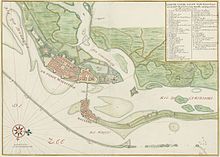| This article needs additional citations for verification. Please help improve this article by adding citations to reliable sources. Unsourced material may be challenged and removed. Find sources: "Mauritsstad" – news · newspapers · books · scholar · JSTOR (June 2024) (Learn how and when to remove this message) |
You can help expand this article with text translated from the corresponding article in French. (October 2022) Click for important translation instructions.
|


Mauritsstad (or Mauritius) was the capital of Dutch Brazil, and is now a part of the Brazilian city of Recife.
History
A Dutch fleet of 65 ships led by Hendrick Corneliszoon Loncq led a siege against Portuguese Brazil in 1630. The Dutch West India Company gained control of Olinda by 16 February 1630, and both Recife and the island of António Vaz (opposite Recife) by 3 March 1630.
The city of Mauritsstad was built on António Vaz and was designed by architect Pieter Post. It was named after Governor Johan Maurits van Nassau-Siegen, who had founded the city and the adjoining palace Vrijburgh. Mauritsstad was the cultural center of the New World, with the first botanical garden and the first zoo in the Americas, and a museum with three hundred stuffed monkeys. The city's Jewish population constructed the first synagogue in the Americas. The city was eventually recaptured by the Portuguese in 1654.
Fort Frederik Hendrik
Main article: Forte de São Tiago das Cinco PontasFort Frederik Hendrik (Forte de São Tiago das Cinco Pontas) was a pentagonal fortress built near Mauritsstad in 1630 that was demolished by the Portuguese in 1677.
References
- "Recife—A City Made by Sugar". Awake!. Retrieved 21 September 2016.
- van Nederveen Meerkerk, H.C. (1991), "Fortificaties in Hollantsch Brasil", Bulletin KNOB, vol. 6, pp. 205–210
- Temminck Groll, C.L.; van Alphen, W. (2002). The Dutch Overseas Architectural Survey: Mutual heritage of four centuries in three continents. Zwolle: Waanders Uitgevers. p. 45.
Categories: